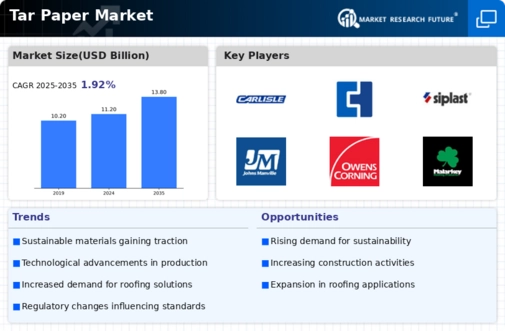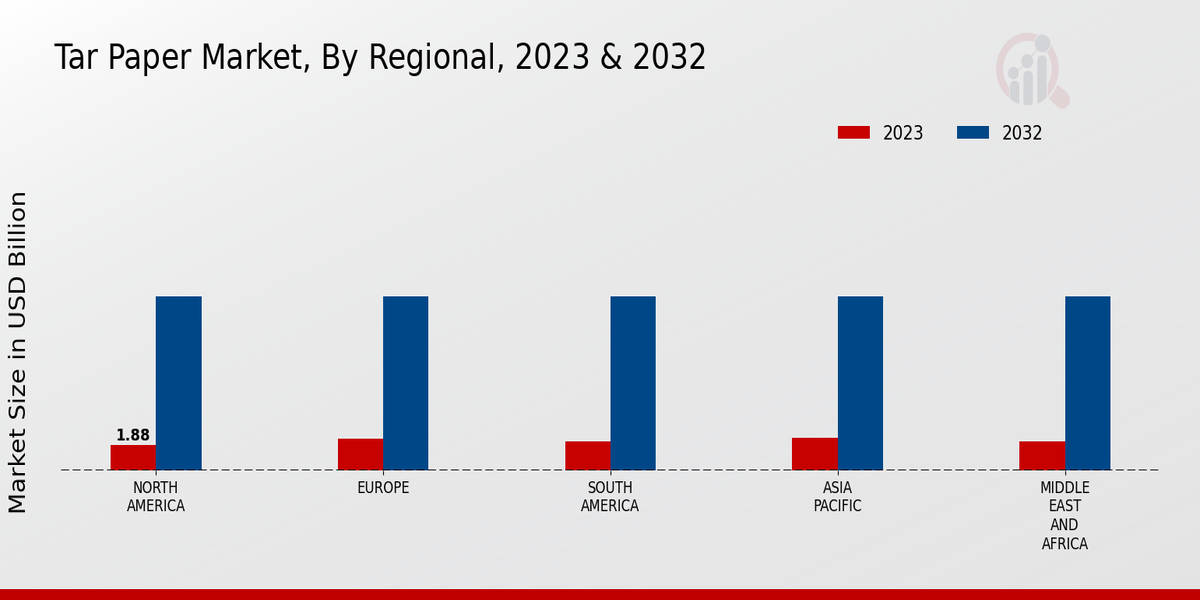Market Growth Projections
The Global Tar Paper Market Industry is poised for growth, with projections indicating a market value of 11.2 USD Billion in 2024 and an anticipated increase to 13.8 USD Billion by 2035. This growth trajectory suggests a steady demand for tar paper, driven by various factors such as the expansion of the construction sector and the increasing preference for sustainable materials. The market is expected to experience a compound annual growth rate (CAGR) of 1.93% from 2025 to 2035, reflecting the ongoing evolution of consumer preferences and regulatory frameworks that favor eco-friendly building materials.
Expansion of the Roofing Industry
The Global Tar Paper Market Industry is closely linked to the expansion of the roofing sector, which is currently witnessing robust growth. With the increasing number of residential and commercial construction projects, the demand for roofing materials, including tar paper, is on the rise. The market is expected to reach 13.8 USD Billion by 2035, reflecting the ongoing investments in infrastructure development. Tar paper's ability to provide effective waterproofing and insulation makes it a preferred choice among builders. This expansion in the roofing industry serves as a significant driver for the Global Tar Paper Market, as it enhances the material's visibility and application.
Increased Awareness of Energy Efficiency
Increased awareness of energy efficiency among consumers is significantly influencing the Global Tar Paper Market Industry. As energy costs continue to rise, homeowners and builders are seeking materials that enhance energy efficiency in buildings. Tar paper, known for its insulation properties, contributes to energy savings by reducing heat loss. This growing awareness is likely to drive demand for tar paper in both residential and commercial applications. The market's projected growth at a CAGR of 1.93% from 2025 to 2035 suggests that as energy efficiency becomes a priority, tar paper will play a crucial role in meeting these demands.
Regulatory Support for Eco-Friendly Products
Regulatory support for eco-friendly products is emerging as a key driver for the Global Tar Paper Market Industry. Governments worldwide are implementing policies that encourage the use of sustainable materials in construction. This regulatory landscape promotes the adoption of tar paper, which is recognized for its environmentally friendly attributes. As regulations become more stringent regarding building materials, the demand for tar paper is expected to rise. This trend not only aligns with global sustainability goals but also positions tar paper as a viable alternative in the construction industry, potentially leading to increased market growth.
Rising Demand for Sustainable Construction Materials
The Global Tar Paper Market Industry is experiencing a notable increase in demand for sustainable construction materials. As environmental concerns gain prominence, builders and contractors are increasingly opting for tar paper due to its eco-friendly properties. This shift is reflected in the market's projected value of 11.2 USD Billion in 2024, indicating a growing preference for materials that minimize environmental impact. Tar paper, known for its durability and weather resistance, aligns with the sustainability goals of the construction sector. Consequently, this trend is likely to drive the market further, as more stakeholders prioritize green building practices.
Technological Advancements in Manufacturing Processes
Technological advancements in manufacturing processes are playing a crucial role in shaping the Global Tar Paper Market Industry. Innovations in production techniques have led to improved quality and performance of tar paper products. Enhanced manufacturing capabilities allow for the creation of tar paper that is more durable and resistant to environmental factors. These advancements not only meet the evolving demands of consumers but also contribute to cost efficiency in production. As a result, the market is likely to benefit from increased adoption of tar paper in various applications, further solidifying its position in the construction materials sector.


 Source: Primary Research, Secondary Research, MRFR Database and Analyst Review
Source: Primary Research, Secondary Research, MRFR Database and Analyst Review






